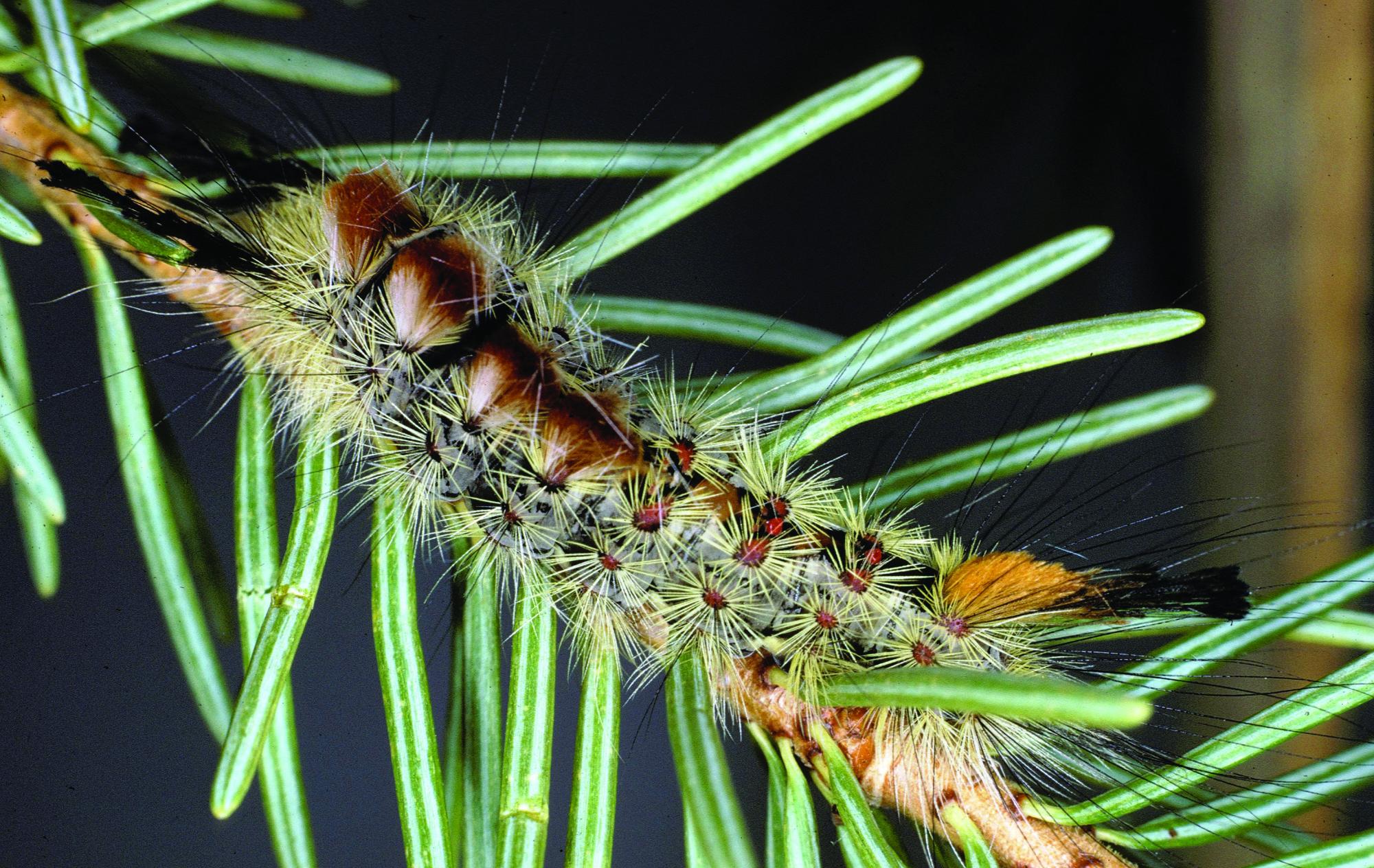
A Douglas-fir tussock moth larva. Image courtesy United States Forest Service.
by Benjamin Recchie
Midwesterners don’t think much about Douglas fir, but these evergreens are important to the Pacific Northwest—both to its economy (as raw material for the timber industry) and to its ecology (as habitat for other living things). But there’s one living thing in the thousands of square miles of Douglas fir forests that worries the staff of the United States Forest Service, which oversees them: the Douglas-fir tussock moth. This moth, while still in its caterpillar stage, feeds on the needles of the Douglas fir, which can in turn injure or kill the tree. Outbreaks of tussock moths can lead to clusters of dead trees and degraded forests. The Forest Service’s attempts to fight the tussock moth eventually drew the interest of Greg Dwyer, professor of ecology and evolution; Dwyer studies the transmission of infectious diseases, sometimes in humans, but also in forest-dwelling insects.
The Forest Service had been trying to develop an environmentally friendly way of controlling the tussock moth by treating the forests with a naturally occurring virus that only infects that insect, destroying its internal organs while still in its caterpillar stage. (Or in Dwyer’s evocative phrase, the infected caterpillar “sort of melts.”) The Forest Service’s early results were successful, he says, but also puzzling. They “discovered that they’ll spray the virus in one area and all the insects will die, but in another area where they don’t spray, the insects will also die of the virus,” he explains. Because the virus is expensive, the Forest Service wanted to find a way to avoid spraying populations that would die on their own without intervention.
Dwyer’s lab first helped the Forest Service determine what kind of data they needed to collect, such as the number of insects in different populations in the forest, the amount of the virus present in the environment, and the fraction of the insects infected as the epidemic proceeds. Then, they developed two hypotheses: either that the virus the Forest Service had been using was weaker than the wild variety, or that there was a reservoir of the virus in the wild that simply took a while to take hold and start an epidemic. Taking the data provided by the Forest Service, the researchers built two models to project the course of an epidemic, one for each hypothesis. Dwyer’s postdoctoral scholar Joseph Mihaljevic used the RCC’s high-performance computing cluster, Midway, to fit stochastic differential equations to their data
A researcher collects Douglas-fir tussock moths in the field. Phot courtesy Joseph Mihaljevic.
“For any given parameter set, we use standard differential-equation-solver software in GSL [Gnu Scientific Library] to generate a large number of predictions of time series of infection rates from our stochastic differential equations,” Dwyer explains. They then calculated a likelihood using Monte Carlo integration, ran the models, and altered their parameters (such as how infectious the disease is, how long it lasts on the trees’ needles, and how quickly it kills its host) until they got a good fit to the data. Finding good parameter values was tricky in this project, he says, but they were able to apply an algorithm developed by Dwyer’s former student David Kennedy called line-search Markov chain Monte Carlo, which allowed them to increase the parallelization of their code and therefore find solutions faster.
Mihaljevic and Dwyer’s results, while preliminary, were clear. “There was a little virus in the non-sprayed population, enough to wipe everything out,” says Dwyer. The virus population lagged behind the tussock moth population; at first, the tussock moth population boomed, but once the virus got traction within the population, it became so widespread that it destroyed the tussock moth population. In addition, there was no reason to believe that the sprayed virus had lost any of its potency.
The models developed for this project are easily generalized to other forest pests, Dwyer says, such as the gypsy moth (a major pest in forests in the eastern US), and even to the spread of human viruses such as HPV. Meanwhile, even as Mihaljevic is preparing a paper on their work, they’re looking toward a larger application: an app that allows forest managers to determine where they need to spray the virus and where the natural population will take care of tussock moths on its own. “I especially like the idea that we have translated code that fits stochastic differential equation models into an app that a forest manager can use,” Dwyer says. Good news for forests, although not so good for the Douglas-fir tussock moth.